Photos with this report (click to enlarge) | |||
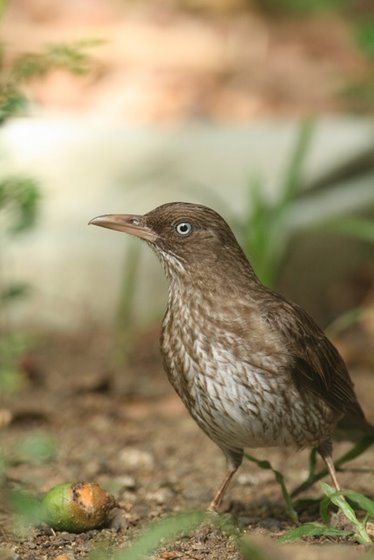 Pearly-eyed Thrasher |
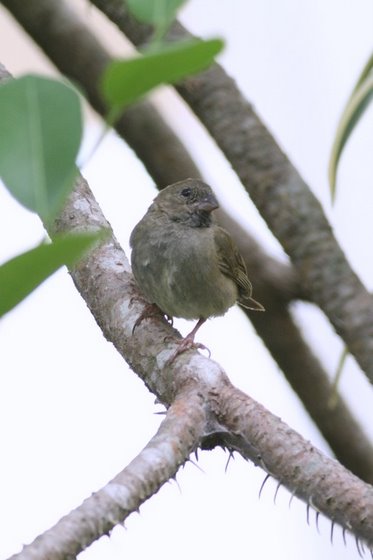 Black-faced Grassquit |
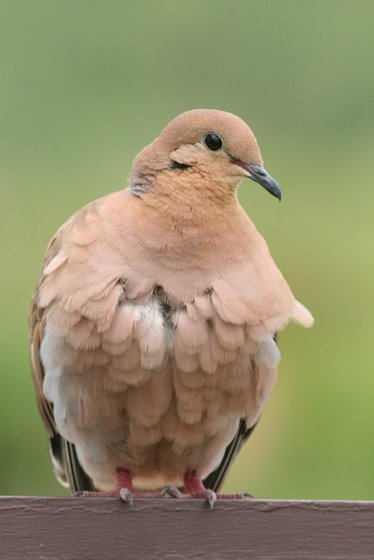 Zenaida Dove |
|
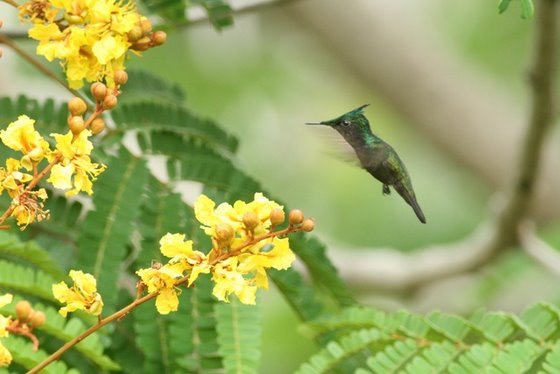 Antillean Crested Hummingbird |
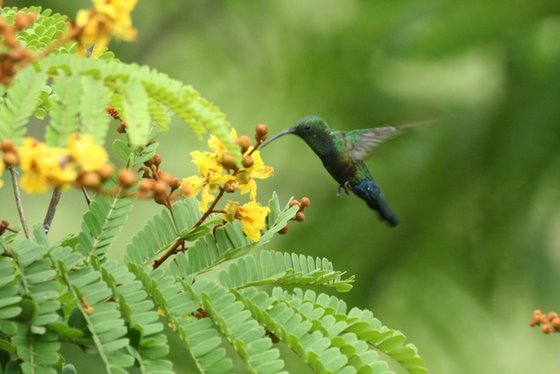 Green-throated Carib |
||
As this was my honeymoon, I wasn't really birding all that hard. It's entirely possible (likely) I could have seen more birds if this were a dedicated birding trip, but I will warn you that there are much better places to visit in June to look for birds than St. Croix.
I totalled 37 species during the week (23-30 June 2008), and a taxonomic list is included at the end.
23 June 2008
We landed at the airport around 4pm (in the summer it's the same time on St. Croix as it is in NYC) and went to the outdoor baggage claim then went to the car rental agency. In typical island fashion, it took about 45 minutes to retrieve our car, despite the lack of any customers ahead of us. Do not expect fast service anywhere on the island.
From the airport we drove north to the Carambola Resort. The resort itself is fairly removed from the rest of the island (about 30+ minutes from the airport, ~15 minutes from Salt River Bay, ~30 minutes from Christiansted, over 1 hour to Point Udall), but it was very comfortable and quite nice to stay at. The beach at the resort had great snorkeling...the one day the 35 knot winds died down enough to allow for it.
On the way to Carambola we saw our first of many dozens of introduced Mongoose. We also saw our first MAGNIFICENT FRIGATEBIRDS and several SCALY-NAPED PIGEONS just perched on wires along the road. On the western half of the island the pigeons were quite common and conspicuous.
At Carambola it was quickly evident that PEARLY-EYED THRASHERS and ZENAIDA DOVES were quite abundant. Both species were fairly tame and often approached too close for my Canon 400mm f/5.6 to focus. Sunset this time of year is sometime around 6pm.
24 June 2008
We spent this day acquainting ourselves with the resort and surrounding area. At breakfast we watched an AMERICAN KESTREL bother some Zenaida Doves, while Pearly-eyed Thrashers tried to grab leftovers before the wait staff removed them. From the breakfast table I spied four BROWN BOOBIES heading west over the sea. While boogie boarding in the copious waves an AMERICAN OYSTERCATCHER bounded past. Every now and then a LAUGHING GULL, ROYAL TERN, Magnificent Frigatebird or BROWN PELICAN would fly by, but it was generally fairly quiet. In the evening I found a half-dozen ANTILLEAN CRESTED HUMMINGBIRDS near our room in a flowering tree. Once I recognized their call I realized that they too were quite abundant at the resort.
In the afternoon we decided to visit Point Udall, the easternmost point in the United States. Here we found ~18 Magnificent Frigatebirds soaring, a BLACK-FACED GRASSQUIT on some cacti, many GRAY KINGBIRDS, a HELMETED GUINEAFOWL, some SMOOTH-BILLED ANI and a NORTHERN MOCKINGBIRD.
25 June 2008
We took an all-day snorkelling trip to Buck Island this day. In Christansted Harbor we saw many CATTLE EGRETS, a LITTLE BLUE HERON, a KILLDEER and many of the oceanic species from yesterday.
On Buck Island I could hear Pearly-eyed Thrashers and BANANAQUITS from shore, and another American Oystercatcher flew past. Some LEAST TERNS were feeding in the area.
We opted for a $90/person snorkel trip....and got to snorkel for about 45 minutes on the reef. If I could do it again, I'd opt for the $45/person half day trip. However, the reef was impressive and well worth a trip if you're on St. Croix.
Back at Carambola in the late afternoon I came across an adult and an immature YELLOW-CROWNED NIGHT-HERON on the eastern edge of the resort. A few Scaly-naped Pigeons also flew around the tree-tops.
26 June 2008
We took a kayaking tour around Salt River Bay from 6pm-8:30pm. Salt River Bay is a must visit if you're on the island. It contained more birds than anywhere else we visited (20+ species), an egret rookery, history, and a general abundance of wildlife.
The egret rookery consisted of mostly Cattle Egrets, but there were also a few GREAT and SNOWY EGRETS mixed in. A couple Little Blue Herons used the area as well. In the mangroves you can easily find BLACK-CROWNED and Yellow-crowned Night-Herons, and GREEN HERONS. If you're patient, you'll probably see a few WHITE-CROWNED PIGEONS flying back and forth between the banks of the bay. YELLOW WARBLERS were singing from all over.
The tour guide was great, but he misidentified a group of ROYAL TERNS as Roseate Terns. A different tour guide made the same mistake when we returned the following morning. The bioluminescence in the bay at night was amazing.
27 June 2008
As mentioned, we took another kayak tour from 9am-noon at Salt River Bay. The rookery had fewer birds than at dusk, but the species were all still well represented. Today several Least Terns were feeding in the bay. When we got to the back of Sugar Bay some WILSON'S PLOVERS were feeding on a mudflat in the mangroves. A couple RED-TAILED HAWKS were screaming above us. A few COMMON GROUND-DOVES were near the abandoned resort building. Otherwise the birds were generally as they were the night before.
28 June 2008
Another trip to Point Udall added CARIBBEAN ELAENIA to the list. Common Ground-Doves were along the main road to the point. Several Brown Boobies were flying around the point. I scanned the ocean from the point for about 30 minutes, but couldn't turn up anything interesting.
29 June 2008
We visited "The Rainforest" on the west end of the island north of Fredriksted in the morning. Not really worth it. A few Scaly-naped Pigeons, the same oceanic birds along the coast, more thrashers and Zenaida Doves. The only highlight was a whining BLACK-WHISKERED VIREO.
On the way back to Carambola we stopped at St. George Botanical Garden near the center of the island. It was a nice walk, especially if you like lizards, but it seemed a bit overpriced. Antillean Crested Hummingbirds were common, and I picked out my first GREEN-THROATED CARIBS of the trip. Bananaquits were abundant. A Black-faced Grassquit was bopping around. Otherwise the birdlife was like Carambola.
Back at Carambola to end the trip. I found a tree east of the guard station flowering at eye-level. Six or seven Antillean Crested Hummingbirds and two or three Green-throated Caribs fed freely while not chasing an enterprising American Kestrel. Scaly-naped Pigeons called from behind me, but they never showed. Plenty of Zenaida Doves and Pearly-eyed Thrashers to keep me company.
1 Helmeted Guineafowl
2 Brown Booby
3 Brown Pelican
4 Magnificent Frigatebird
5 Great Blue Heron
6 Great Egret
7 Snowy Egret
8 Little Blue Heron
9 Cattle Egret
10 Green Heron
11 Black-crowned Night-Heron
12 Yellow-crowned Night-Heron
13 Red-tailed Hawk
14 American Kestrel
15 Wilson's Plover
16 Killdeer
17 American Oystercatcher
18 Laughing Gull
19 Least Tern
20 Royal Tern
21 Rock Pigeon
22 Scaly-naped Pigeon
23 White-crowned Pigeon
24 Zenaida Dove
25 Common Ground-Dove
26 Smooth-billed Ani
27 Green-throated Carib
28 Antillean Crested Hummingbird
29 Caribbean Elaenia
30 Gray Kingbird
31 Black-whiskered Vireo
32 Northern Mockingbird
33 Pearly-eyed Thrasher
34 Yellow Warbler
35 Bananaquit
36 Black-faced Grassquit
37 House Sparrow